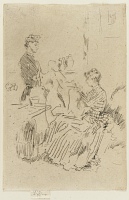Etchings Institutions search term: grolier club
The Seamstress | ||
| Number: | 253 | |
| Date: | 1886 | |
| Medium: | etching and drypoint | |
| Size: | 99 x 66 mm | |
| Signed: | butterfly at left | |
| Inscribed: | no | |
| Set/Publication: | no | |
| No. of States: | 3 | |
| Known impressions: | 4 | |
| Catalogues: | K.252; M.248; W.206 | |
| Impressions taken from this plate (4) | ||
KEYWORD
dress, interior, sewing, woman seated, woman standing, worker.
TITLE
It has always been known by the same title, although Whistler sometimes left out 'The', as follows:
'The Seamstress' (1886, Frederick Wedmore (1844-1921)). 3
Possibly 'Miss Grimlly' [sic] (1887/1888, Whistler). 4
'Seamstress' (1887, Whistler). 5
'The Seamstress' (1887, Whistler). 6
Possibly 'Grimley. Miss' (1890/1892, Beatrice Whistler (1857-1896)). 7
Since it is not certain that Miss Grimley is the seamstress, the published title, 'The Seamstress', also used by Whistler, is preferred.
'The Seamstress' (1886, Frederick Wedmore (1844-1921)). 3
Possibly 'Miss Grimlly' [sic] (1887/1888, Whistler). 4
'Seamstress' (1887, Whistler). 5
'The Seamstress' (1887, Whistler). 6
Possibly 'Grimley. Miss' (1890/1892, Beatrice Whistler (1857-1896)). 7
Since it is not certain that Miss Grimley is the seamstress, the published title, 'The Seamstress', also used by Whistler, is preferred.
3: Wedmore 1886 A (cat. no. 206).
4: List, [August 1887/1888], GUW #13233.
5: List, [8 February-29 September 1887], GUW #12716.
6: 27 July 1887, GUW #08677.
7: List, GUW #12715.
DESCRIPTION
A woman seated at the right is holding up a piece of cloth; she is wearing a chequered blouse and striped or pleated skirt, she has a short fringe and her hair is pulled up into a bun on top of her head. On the left is the corner of a table, and behind it, a woman stands facing right, looking down on the seated woman; she wears a plain dark dress with a white apron, and a small hat. In the background is another woman sitting at a table, facing away. Above her, on a shelf, are two vases, and at upper right, a picture hangs on the wall.
SITTER
Wedmore commented, 'A sketch of two young women, one of whom sits. The other - probably a servant - stands. Some work between them'. The assumption of the relative status of the two women may be incorrect, although it is true that the standing woman wears an apron.
One of the women may be Emma C. Grimley, a seamstress, born about 1864. 'Miss Grimley - / 43 - Sladeburn Street / Chelsea' was recorded by Whistler in a notebook about 1885 or 1886. This might be because she was a possible model or employee. 8 On 29 April 1886 'Miss Grimley' was invited to Whistler's exhibition at Messrs Dowdeswell's. 9 This suggests she was a respectable acquaintance, rather than a servant.
8: GUL PC14, p. 3.
9: GUW #09096.
The Grimleys lived at 44 Slaidburn Street in Chelsea, near Whistler's house. The 1881 UK census shows George M. Grimley, aged 34, a waterman living with his wife Emma, aged 30, and six children: George K.J.W., aged 19, also a waterman; Emma C., a dressmaker aged 17; Albert H., 'Call Boy on a Steamer' aged 16; Alice R. aged 12; Elizabeth J. aged 8, and Selina R. aged 3. 10 In 1887, Emma would have been 23 and Alice, 18. Emma, as a dress-maker, is the most likely to have known Whistler, and as the eldest, would be referred to as 'Miss Grimley'. As a dressmaker, she could well have been also called a 'Seamstress'.
10: http://familysearch.org (accessed 2010).
Slaidburn (not Sladeburn or Staidburn) Street was in a poor area of Chelsea, described by the social reformer Charles Booth:
'a cul-de-sac, asphalt-paved, one of the worst streets in Chelsea and I should say one of the worst in London - drunken, rowdy, constant trouble to police: many broken patched windows, open doors, drink-sodden women at windows.' 11
11: Charles Booth Online Archive, B362, p.185, at http://booth.lse.ac.uk (accessed 2010).
The Grimleys, a family of eight, with two watermen, a dress-maker, and a call-boy, were clearly not prosperous, but were not necessarily 'drunken' or 'rowdy'. Although a woman living in this environment was more likely to be prepared to pose either clothed and nude, the respectability of Emma's trade suggests she would have posed clothed. Dress-makers were usually ill-paid, but still had to dress well in order to attract customers.
DISCUSSION
The fact that Miss Grimley's name was crossed out in Beatrice Whistler's stocktaking list suggests that the etching turned out to have another name, and was recorded elsewhere in the document. However, if the sitter in The Seamstress is not 'Miss Grimley', then she may have sat for some other etching. The Seamstress
[253], for instance, is in the same list recorded by Beatrice Whistler. There are also a few unidentified portraits of the period, which include The Little Hat
[366] and The Little Cloak
[370].
